Toolkit: Discovery Workshop to Define the Ethical and Responsible AI Roadmap
Workshop methodology
How to create an approach for ethical and responsible AI, and define the roadmap to operationalize
Introduction & Objective
This workshop is designed for businessess to execute internally, to build an initial understanding about what ethical considerations their use of AI is associated with, and what actions are needed to fully operationalize ethical and responsible AI within their organization.
Process & Timeline
The workshop consists of four exercises that guide the participants to identify their organization’s AI opportunities and risks. The workshop begins with a high-level inventory of current practices to identify the organizations starting point, and ends with defining a roadmap and action plan to improve current processes or create new practices that help ensure alignment with AI principles. The workshop exercises are conducted in sequential order with a estimated completion time of 2,5 hours.
Exercises & Participants
The workshop is designed to be cross-functional, and the exercices require knowledge about current and future AI operatations from multiple perspectives. The recommendation is to form a core workshop team of not more than 10 people, who can later validate the findings with other relevant stakeholders. Recommended perspectives to have included in the workshop are AI/Data Science, Data Engineering, Legal, Product, HR/Learning & Development.
Expected Outcome
This workshop is meant to be a starting point for organizations to create a formal roadmap to mature critical capabilities needed to develop and/or use AI responsibly. After completing the workshop, the organization will have defined and prioritized short- and long-term initiatives to address critical gaps identified in current ways of developing and/or using AI. This is the first step towards establishing a unified approach for ethical and responsible AI.
Overview of the exercises & output
Exercise: 0.5 – Health check
(time ~ 20min)
(time ~ 20min)
Identifying the current ethical and responsible AI state by completing the check-list and identify areas where the organization is lacking to fully operationalize ethical and responsible AI .
Exercise: 1 – Define your AI context
(time ~ 40min)
(time ~ 40min)
Understanding your AI vision and associated risks, to better define ethical and responsible AI principles.
Exercise: 2 – Identify critical gaps
(time ~ 40min)
(time ~ 40min)
Mapping out the current known practices and processes that are connected to the current principles for ethical and responsible AI , as well as identifying any gaps.
Exercise: 3 – Define principles and roadmap
(time ~50min)
(time ~50min)
Identifying prioritized initiatives, and ethical and responsible AI principles,including both short- and long-term priorities.
Output: Outlined a short- and long-term plan ofinitiatives
Exercise 0.5: Health Check
Task | ❶ Together in the large group, fill out the Health check questionnaire to map the high-level state of your organization’s current responsible AI practices (20 min) |
Tools | Template Exercise 0.5: Health Check |
Time | Total time 20 minutes |
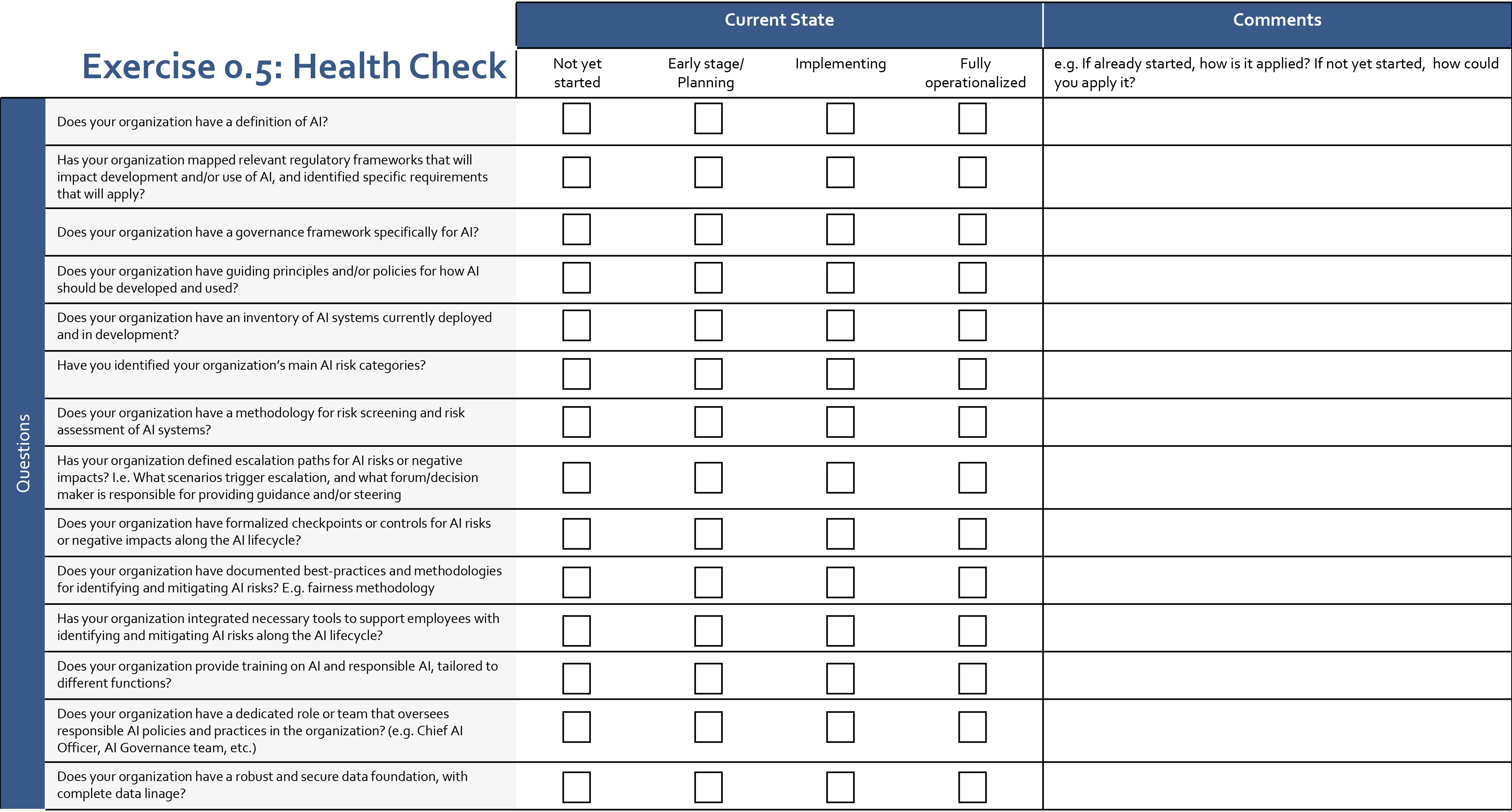
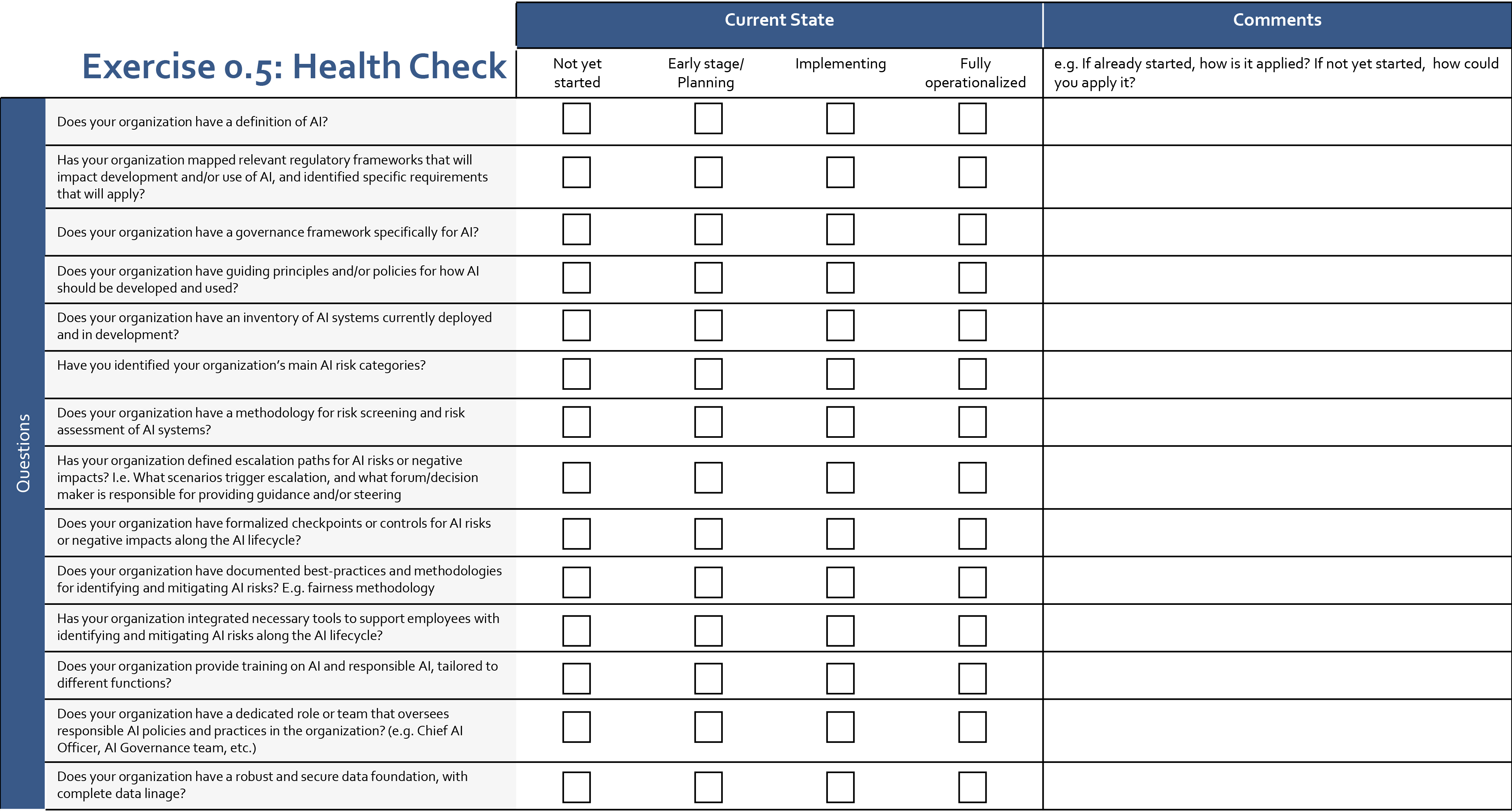
Exercise 1: Define your organization’s AI context
Task | ❶ Together in the large group, evaluate your organization’s current and future use of AI (10 min) a)What is your organization’s definition of AI b)How is your organization currently using AI c)How will your organization use AI in the future ❷ Together in the large group, define and document your organization’s main AI risk categories (15 min) ❸ Together in the large group, outline and document relevant guiding principles to help operationalize AI responsibly within your organization (15 min) |
Tools | Template Exercise 1: Define your organization’s AI context |
Time | Total time 40 minutes |
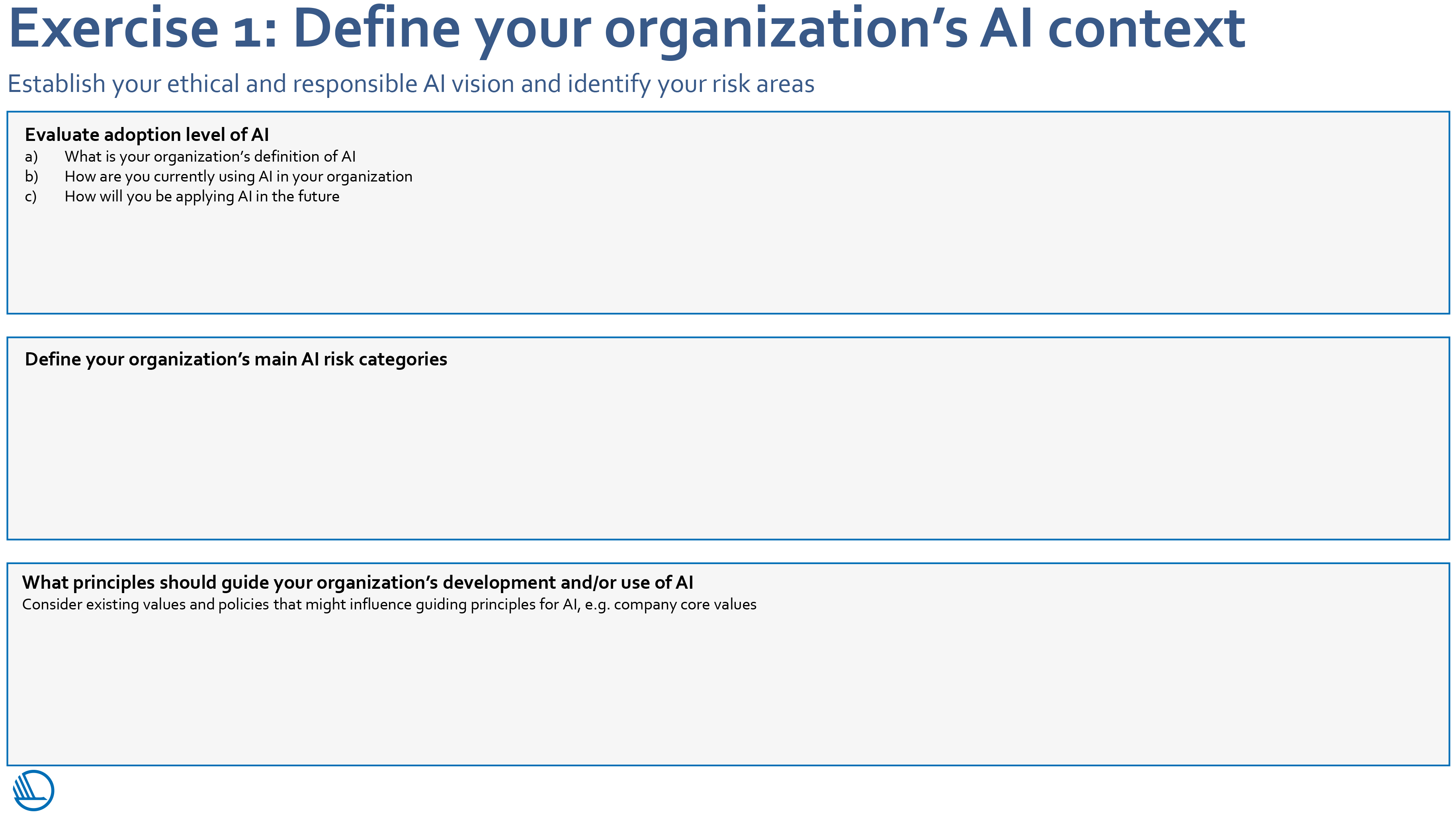
Exercise 1: Define your organization’s AI context
Establish your ethical and responsible AI vision and identify your risk areas
Evaluate adoption level of AI
|
Define your organization’s main AI risk categories |
What principles should guide your organization’s development and/or use of AI Consider existing values and policies that might influence guiding principles for AI, e.g. company core values |
Exercise 2: Identify critical gaps
Task | ❶ Individually identify current practices and processes that support upholding of the guiding principles defined in exercise 1. Write them down on post-it notes (5 min) ❷ Individually identify lacking capabilities that are needed to uphold the guiding principles defined in exercise 1. If needed, leverage the framework provided in this guidebook to categorize the capabilities. Write them down on post-it notes (10 min) ❸ Together in the large group, discuss the missing capabilities and prioritize the most critical ones (25 min) |
Tools | Post-it notes |
Time | Total time 40 minutes |


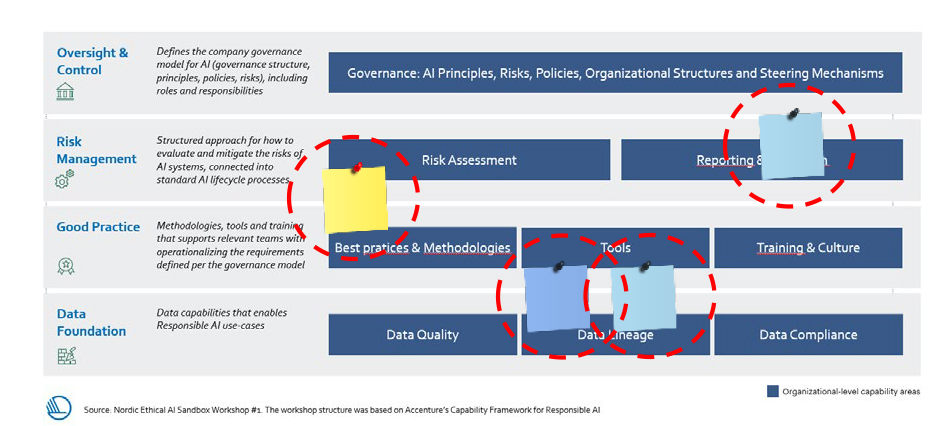
Exercise 3: Prioritize and document initiatives
Task | ❶ Individually list up to 7 potential initiatives for your organization that address the identified gaps from exercise 2 and support with upholding the guiding principles identified in exercise 1 (5 min) ❷ Together in the large group, discuss the proposed initiatives and prioritize 5 in total (15 min) ❸ Together in the large group, detail the prioritized initiatives according to the provided template (30 min) |
Tools | Template Exercise 3: Responsible AI Initiatives Post-it notes |
Time | Total time 50 minutes |


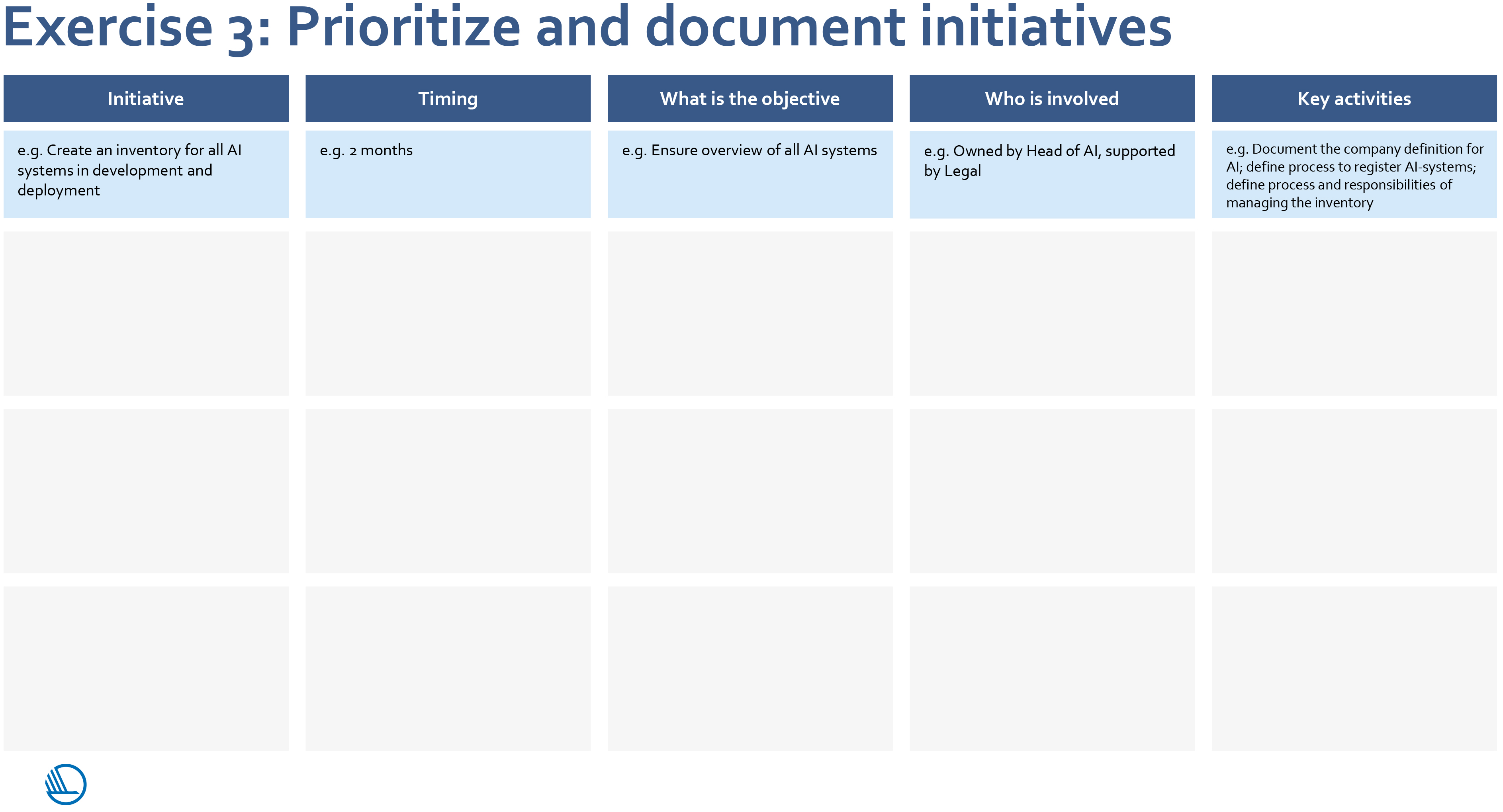
Exercise 3: Prioritize and document initiatives
Initiative | Timing | What is the objective | Who is involved | Key activities |
e.g. Create an inventory for all AI systems in development and deployment | e.g. 2 months | e.g. Ensure overview of all AI systems | e.g. Owned by Head of AI, supported by Legal | e.g. Document the company definition for AI; define process to register AI-systems; define process and responsibilities of managing the inventory |